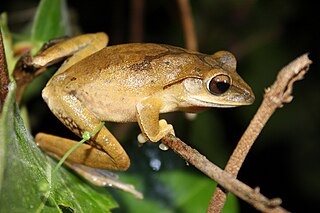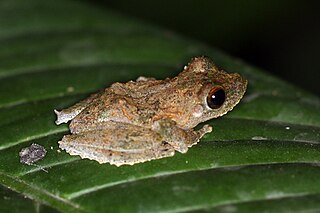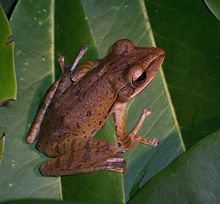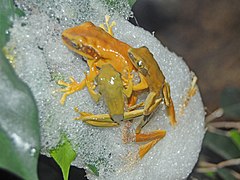
The Rhacophoridae are a family of frogs that occur in tropical sub-Saharan Africa, South India and Sri Lanka, Japan, northeastern India to eastern China and Taiwan, south through the Philippines and Greater Sundas, and Sulawesi. They are commonly known as shrub frogs, or more ambiguously as "moss frogs" or "bush frogs". Some Rhacophoridae are called "tree frogs". Among the most spectacular members of this family are numerous "flying frogs".

Polypedates is a genus of frogs in the family Rhacophoridae, the shrub frogs and Paleotropic tree frogs. They belong to subfamily Rhacophorinae. Members of this genus are collectively known as whipping frogs. They occur in eastern and southern Asia.

Polypedates megacephalus, the Hong Kong whipping frog or spot-legged tree frog, is a species in the shrub frog family (Rhacophoridae). In its native range, it is also called "brown tree frog", but this name is otherwise applied to a species of the true tree frog family (Hylidae).

The painted narrowmouth toad, or slender-digit chorus frog, is a species of frog in the family Microhylidae.

The common green frog is a frog species of in the true frog family Ranidae; some sources still use the old name Rana erythraea. It lives in Southeast Asia and is also known as green paddy frog, red-eared frog or leaf frog. The last name, however, commonly refers to the Neotropical tree frogs which make up the subfamily Phyllomedusinae. These are not closely related to H. erythraea, belonging to family Hylidae instead.

Chirixalus doriae, commonly known as Doria's Asian treefrog, Doria's bush frog, Doria's bush frog, and Doria's tree frog, is a species of frog in the family Rhacophoridae. It is found in southeastern Asia, from extreme northeastern India and adjacent Bangladesh to Myanmar, Thailand, Cambodia, Laos, Vietnam, and southern China.

Polypedates cruciger is a species of frog in the family Rhacophoridae endemic to Sri Lanka.
Zhangixalus dorsoviridis, also known as the green-back treefrog, is a species of frog in the family Rhacophoridae that is found in northern Vietnam and southern China (Yunnan). It may be confused with Rhacophorus nigropunctatus. Its natural habitats are subtropical or tropical moist montane forests, freshwater marshes, and intermittent freshwater marshes. It is threatened by habitat loss.
Polypedates hecticus is a species of frog in the family Rhacophoridae. It is endemic to Samar, Philippines.

Polypedates macrotis, commonly known as the dark-eared treefrog, sometimes also Bongao tree frog, Bongao bubble-nest frog, Baram whipping frog, or brown-striped tree frog, is a species of frog in the family Rhacophoridae. It is found in the central peninsular Thailand, Sumatra, Borneo, and Sulu Archipelago as well as a range of other Philippine islands.
Rhacophorus nigropunctatus is a species of frog in the family Rhacophoridae. It is found in China, possibly Myanmar, and possibly Vietnam.

The frilled tree frog, rough-armed tree frog, or Southeast Asian tree frog is a species of frog in the family Rhacophoridae found in Brunei, Cambodia, India, Indonesia, Malaysia, Myanmar, the Philippines, Thailand, and Vietnam. Its natural habitats are subtropical or tropical moist lowland forest, subtropical or tropical swamps, subtropical or tropical moist shrubland, rivers, swamps, freshwater marshes, and intermittent freshwater marshes. It is threatened by habitat loss.
Leptomantis bimaculatus is a species of frog in the moss frog family (Rhacophoridae). Described by Wilhelm Peters in 1867, it is endemic to the Philippines. There, it is known to occur on the islands of Bohol, Mindanao, and in the south of Luzon; it might also be found on other islands as its known range brackets the main chain of the Philippines archipelago.

The Chinese flying frog or Chinese gliding frog is a species of tree frog in the family Rhacophoridae found in China, Laos, Burma, and Vietnam. It is also known as Blanford's whipping frog, large treefrog, and Denny's whipping frog.
Rhacophorus orlovi is a species of frog in the family Rhacophoridae. The species is endemic to Southeast Asia.

Zhangixalus owstoni or Owston's green tree frog is a species of frog in the family Rhacophoridae endemic to Japan. Its natural habitats are subtropical or tropical moist lowland forests, subtropical or tropical seasonally wet or flooded lowland grassland, intermittent freshwater marshes, and irrigated land. It is threatened by habitat loss. The population is currently stable.

The harlequin tree frog is a species of frog in the family Rhacophoridae found in Brunei, Indonesia, Malaysia, Thailand, and the Philippines. Its natural habitats are subtropical or tropical moist lowland forest, subtropical or tropical moist montane forest, freshwater marshes, and intermittent freshwater marshes. It is threatened by habitat loss.

Rhacophorus reinwardtii is a species of frog in the family Rhacophoridae. It is variously known under the common names of black-webbed treefrog, green flying frog, Reinwardt's flying frog, or Reinwardt's treefrog. Before 2006, Rhacophorus reinwardtii and Rhacophorus kio were considered to be the same species. It is not considered threatened by the IUCN.
Robinson's tree frog is a species of frog in the family Rhacophoridae found in Malaysia and Thailand. Its natural habitats are subtropical or tropical moist lowland forests and intermittent freshwater marshes. It is threatened by habitat loss.
Polypedates iskandari is a species of frogs in the family Rhacophoridae. It is endemic to Sulawesi, Indonesia. It belongs to the Polypedates leucomystax species complex; it was split from Polypedates leucomystax in 2011 based on a morphometric analysis. This split has been challenged because male vocalizations between specimens from Sulawesi and Java show only minor differences and because genetic differences are low.
















